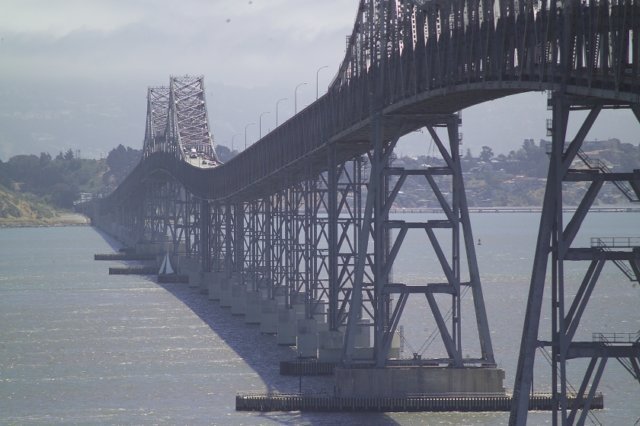Chunks of the Richmond-San Rafael (RSR) bridge are falling off. And now North Bay Assemblyman Marc Levine is discussing replacing the 63-year-old span.
But if we're going to replace it, does it make sense to rebuild it as another freeway bridge? "Where is the transit piece of this? The same piece that has been missing from the discussion of the RSR Bridge added car lane project," wrote Bike East Bay's Dave Campbell, in an email to Streetsblog.
As part of its planning, the Metropolitan Transportation Commission has already obtained an estimate from Caltrans of $8.2 billion to replace the RSR bridge with another car bridge.
How much would it cost to add rail on the bridge? That's listed as "TBD."
Levine says he isn't taking a position. Instead, he's launched a web poll to see what his constituents think.
Additionally, Levine wrote that he met with officials from "Caltrans, the Metropolitan Transportation Commission and the Transportation Authority of Marin to discuss ongoing questions about the safety and efficiency of the Richmond-San Rafael Bridge." He also points out that the bridge is used by 80,000 drivers a day.
For comparison, over 60,000 people ride through BART's Transbay Tube an hour during peak times of the day. And that's on just two tracks, the space equivalent of two lanes versus the five on the bridge.
All of which is to point out that if "efficiency" is really the main concern, then building a relatively narrow rail-only bridge (20 feet wide plus a safety accessway, which can double as a bike path, is enough for a track in each direction) is far more efficient for moving people than any freeway bridge. Plus there's no traffic jams and pollution. And if safety is the concern, can we talk again about the number of people killed and seriously injured in Bay Area car crashes?
Rail is the obvious choice for this crossing. The Marin side of the bridge starts a little over a mile from the new SMART train extension to Larkspur. The Point Richmond side of the bridge flies right over freight tracks that connect to Amtrak's Capitol Corridor line. SMART trains are standard gauge, so if the bridge had rail, and these short connections built, it would be possible to run trains directly from Sonoma to Marin to Richmond to Oakland all the way to San Jose.

Depending how it's designed, SMART passengers could transfer to BART at Richmond. And someday, when a second Transbay tube is built, North Bay residents would have that long-dreamed-of, one-seat ride to San Francisco.
Yes, a newly combined Amtrak/SMART system would eventually have to be electrified and upgraded, along the lines of what Caltrain is doing right now, to reach full potential. But the transformational potential of a rail bridge connecting the North and East Bay is too big to ignore.
However, Caltrans, the state transportation agency, still thinks their job is to move cars, not people. If their planning follows the usual pattern, no one will ever get the cost of a pure rail bridge to compare to the cost-per-capacity of a road bridge. Instead, they'll start from the paradigm that this is a freeway bridge, and at some point in the future they'll tell the public that adding rail will double the price, or at least cost many billions more. All of which mis-frames the discussion and virtually assures the rail connection will never happen.
That's why MTC and Caltrans have it backwards. This should be viewed as a rail project. The cost of adding a road deck for private automobiles is the only thing that should be "TBD."
Meanwhile, it's probably a good idea for progressive thinkers in the safe-streets community to take Levine's poll about the bridge.






